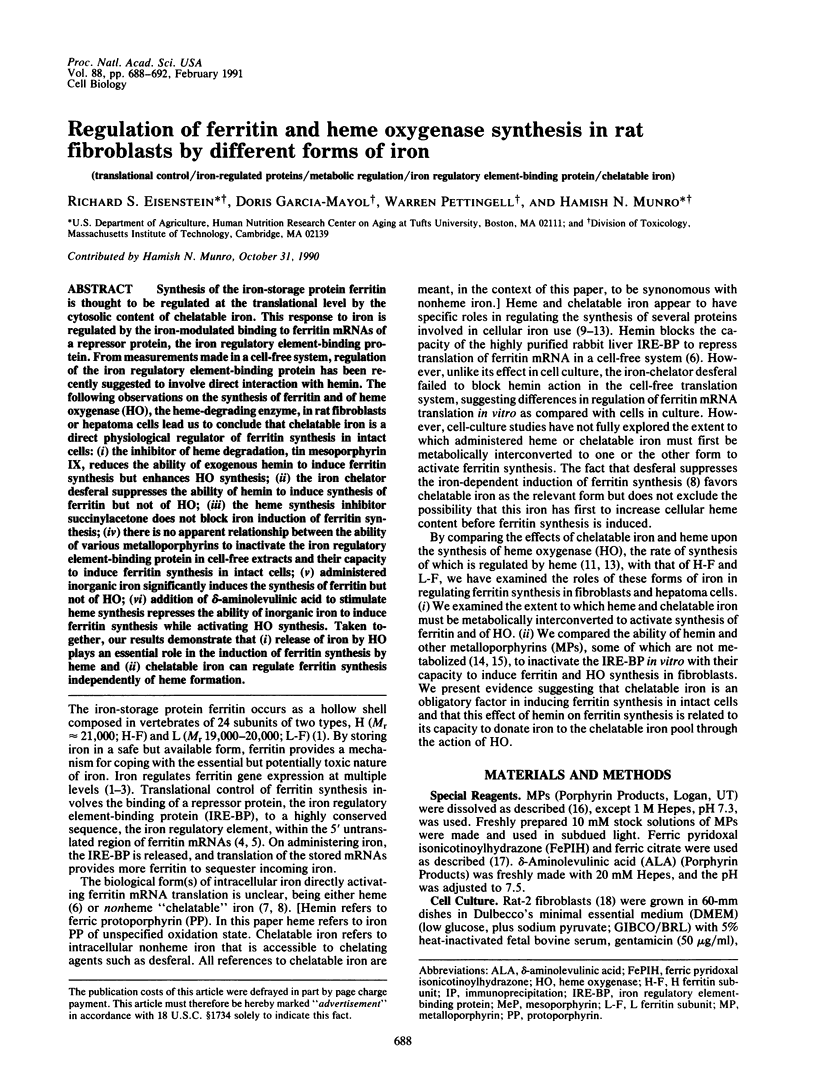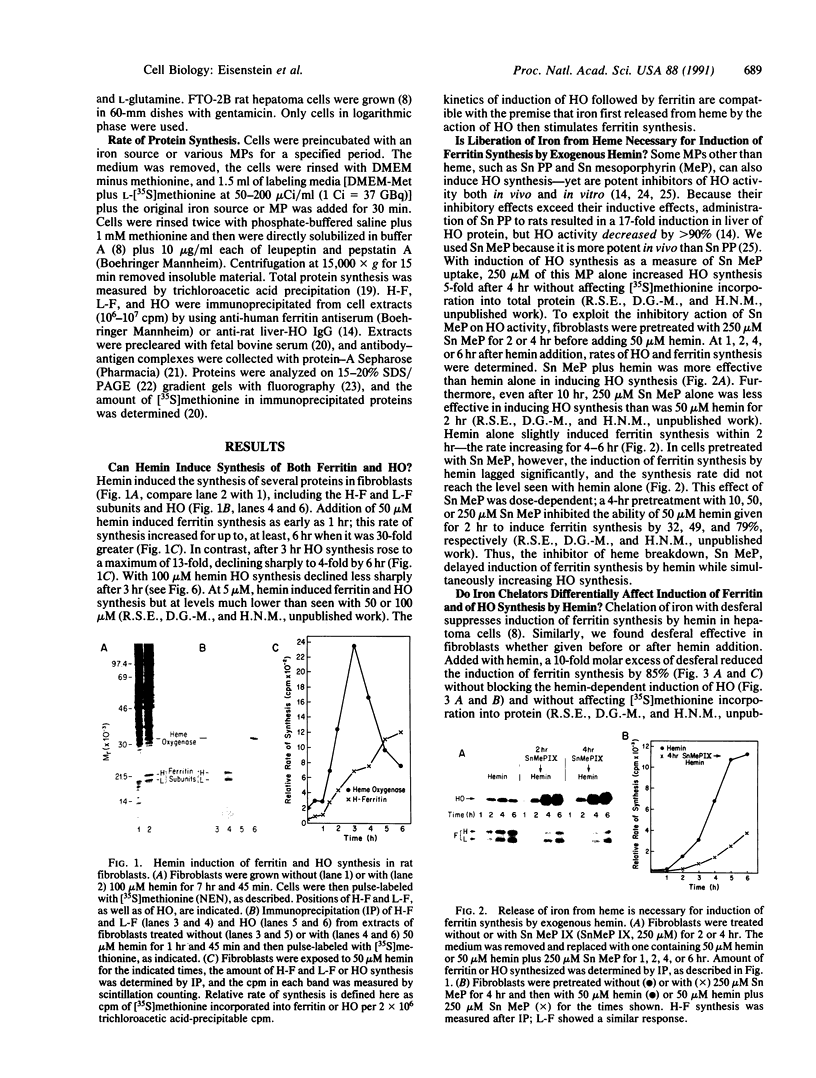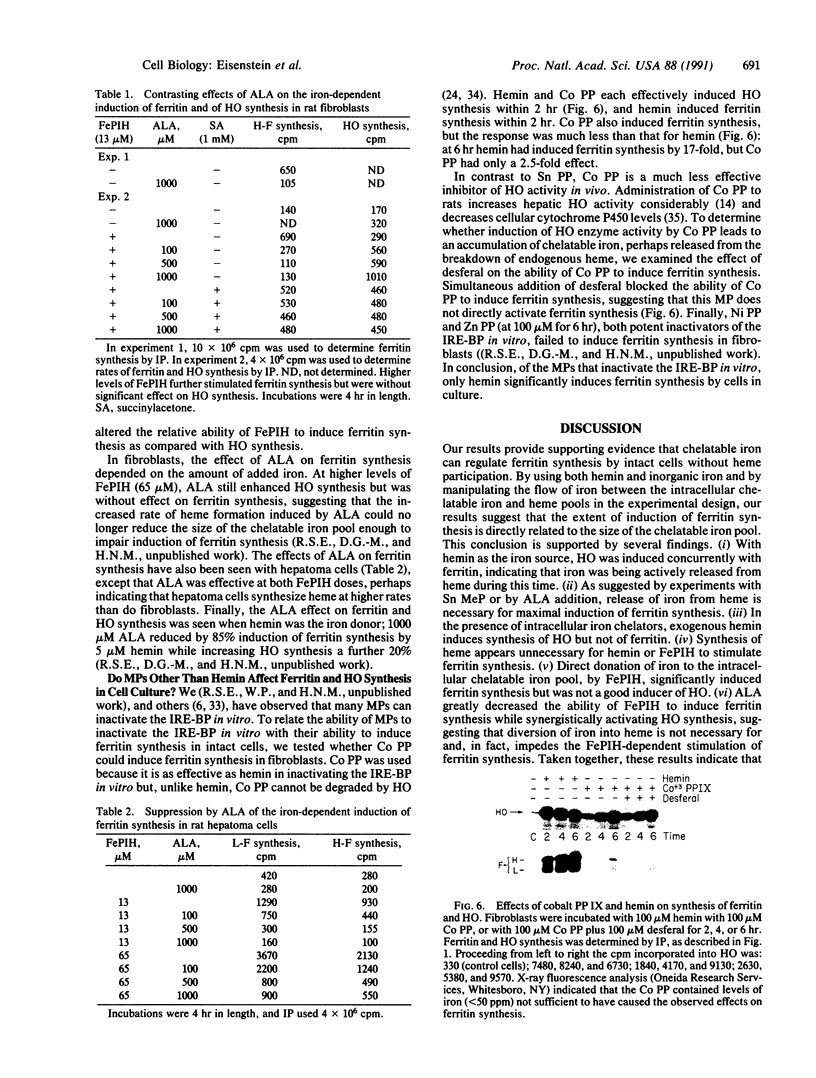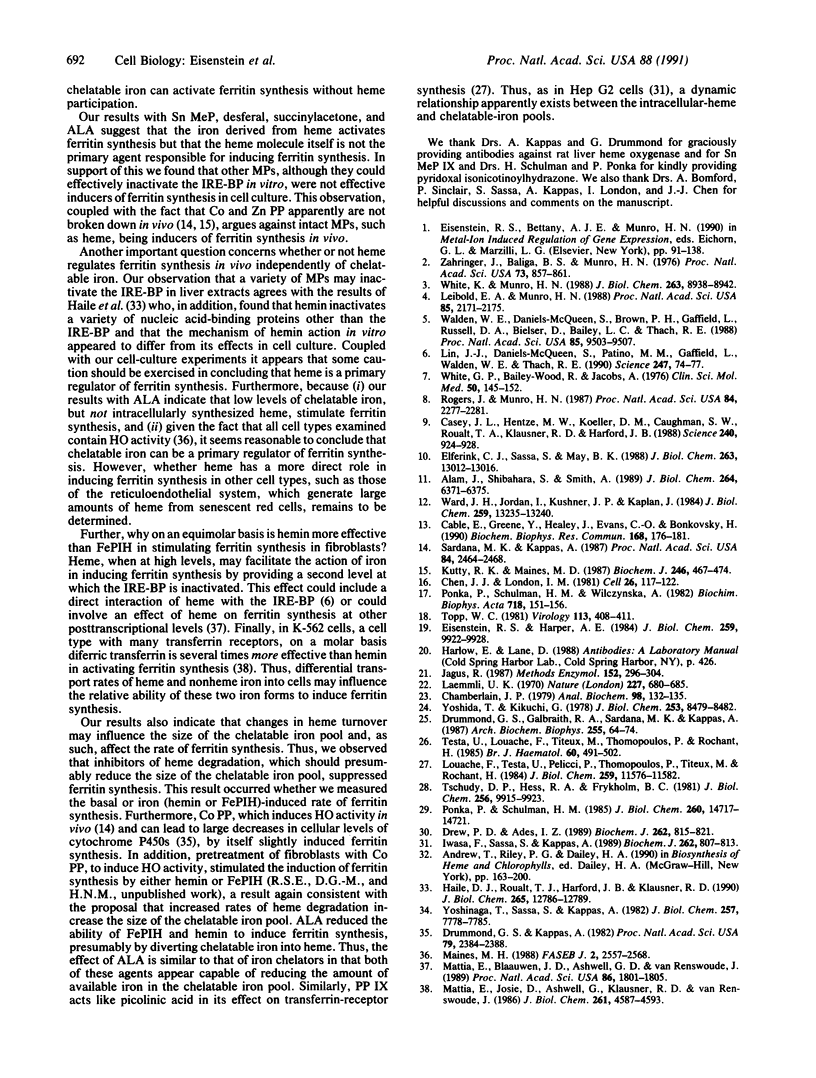Abstract
Synthesis of the iron-storage protein ferritin is thought to be regulated at the translational level by the cytosolic content of chelatable iron. This response to iron is regulated by the iron-modulated binding to ferritin mRNAs of a repressor protein, the iron regulatory element-binding protein. From measurements made in a cell-free system, regulation of the iron regulatory element-binding protein has been recently suggested to involve direct interaction with hemin. The following observations on the synthesis of ferritin and of heme oxygenase (HO), the heme-degrading enzyme, in rat fibroblasts or hepatoma cells lead us to conclude that chelatable iron is a direct physiological regulator of ferritin synthesis in intact cells: (i) the inhibitor of heme degradation, tin mesoporphyrin IX, reduces the ability of exogenous hemin to induce ferritin synthesis but enhances HO synthesis; (ii) the iron chelator desferal suppresses the ability of hemin to induce synthesis of ferritin but not of HO; (iii) the heme synthesis inhibitor succinylacetone does not block iron induction of ferritin synthesis; (iv) there is no apparent relationship between the ability of various metalloporphyrins to inactivate the iron regulatory element-binding protein in cell-free extracts and their capacity to induce ferritin synthesis in intact cells; (v) administered inorganic iron significantly induces the synthesis of ferritin but not of HO; (vi) addition of delta-aminolevulinic acid to stimulate heme synthesis represses the ability of inorganic iron to induce ferritin synthesis while activating HO synthesis. Taken together, our results demonstrate that (i) release of iron by HO plays an essential role in the induction of ferritin synthesis by heme and (ii) chelatable iron can regulate ferritin synthesis independently of heme formation.
Full text
PDF




Images in this article
Selected References
These references are in PubMed. This may not be the complete list of references from this article.
- Alam J., Shibahara S., Smith A. Transcriptional activation of the heme oxygenase gene by heme and cadmium in mouse hepatoma cells. J Biol Chem. 1989 Apr 15;264(11):6371–6375. [PubMed] [Google Scholar]
- Cable E., Greene Y., Healey J., Evans C. O., Bonkovsky H. Mechanism of synergistic induction of hepatic heme oxygenase by glutethimide and iron: studies in cultured chick embryo liver cells. Biochem Biophys Res Commun. 1990 Apr 16;168(1):176–181. doi: 10.1016/0006-291x(90)91690-t. [DOI] [PubMed] [Google Scholar]
- Casey J. L., Hentze M. W., Koeller D. M., Caughman S. W., Rouault T. A., Klausner R. D., Harford J. B. Iron-responsive elements: regulatory RNA sequences that control mRNA levels and translation. Science. 1988 May 13;240(4854):924–928. doi: 10.1126/science.2452485. [DOI] [PubMed] [Google Scholar]
- Chamberlain J. P. Fluorographic detection of radioactivity in polyacrylamide gels with the water-soluble fluor, sodium salicylate. Anal Biochem. 1979 Sep 15;98(1):132–135. doi: 10.1016/0003-2697(79)90716-4. [DOI] [PubMed] [Google Scholar]
- Chen J. J., London I. M. Hemin enhances the differentiation of mouse 3T3 cells to adipocytes. Cell. 1981 Oct;26(1 Pt 1):117–122. doi: 10.1016/0092-8674(81)90039-8. [DOI] [PubMed] [Google Scholar]
- Drew P. D., Ades I. Z. Regulation of production of delta-aminolaevulinate synthase in tissues of chick embryos. Effects of porphyrogenic agents and of haem precursors. Biochem J. 1989 Sep 15;262(3):815–821. doi: 10.1042/bj2620815. [DOI] [PMC free article] [PubMed] [Google Scholar]
- Drummond G. S., Galbraith R. A., Sardana M. K., Kappas A. Reduction of the C2 and C4 vinyl groups of Sn-protoporphyrin to form Sn-mesoporphyrin markedly enhances the ability of the metalloporphyrin to inhibit in vivo heme catabolism. Arch Biochem Biophys. 1987 May 15;255(1):64–74. doi: 10.1016/0003-9861(87)90294-3. [DOI] [PubMed] [Google Scholar]
- Drummond G. S., Kappas A. The cytochrome P-450-depleted animal: an experimental model for in vivo studies in chemical biology. Proc Natl Acad Sci U S A. 1982 Apr;79(7):2384–2388. doi: 10.1073/pnas.79.7.2384. [DOI] [PMC free article] [PubMed] [Google Scholar]
- Eisenstein R. S., Bettany A. J., Munro H. N. Regulation of ferritin gene expression. Adv Inorg Biochem. 1990;8:91–138. [PubMed] [Google Scholar]
- Eisenstein R. S., Harper A. E. Characterization of a protein synthesis system from rat liver. Translation of endogenous and exogenous messenger RNA. J Biol Chem. 1984 Aug 10;259(15):9922–9928. [PubMed] [Google Scholar]
- Elferink C. J., Sassa S., May B. K. Regulation of 5-aminolevulinate synthase in mouse erythroleukemic cells is different from that in liver. J Biol Chem. 1988 Sep 15;263(26):13012–13016. [PubMed] [Google Scholar]
- Haile D. J., Rouault T. A., Harford J. B., Klausner R. D. The inhibition of the iron responsive element RNA-protein interaction by heme does not mimic in vivo iron regulation. J Biol Chem. 1990 Aug 5;265(22):12786–12789. [PubMed] [Google Scholar]
- Iwasa F., Sassa S., Kappas A. delta-Aminolaevulinate synthase in human HepG2 hepatoma cells. Repression by haemin and induction by chemicals. Biochem J. 1989 Sep 15;262(3):807–813. doi: 10.1042/bj2620807. [DOI] [PMC free article] [PubMed] [Google Scholar]
- Jagus R. Characterization of in vitro translation products. Methods Enzymol. 1987;152:296–304. doi: 10.1016/0076-6879(87)52034-1. [DOI] [PubMed] [Google Scholar]
- Kutty R. K., Maines M. D. Characterization of an NADH-dependent haem-degrading system in ox heart mitochondria. Biochem J. 1987 Sep 1;246(2):467–474. doi: 10.1042/bj2460467. [DOI] [PMC free article] [PubMed] [Google Scholar]
- Laemmli U. K. Cleavage of structural proteins during the assembly of the head of bacteriophage T4. Nature. 1970 Aug 15;227(5259):680–685. doi: 10.1038/227680a0. [DOI] [PubMed] [Google Scholar]
- Leibold E. A., Munro H. N. Cytoplasmic protein binds in vitro to a highly conserved sequence in the 5' untranslated region of ferritin heavy- and light-subunit mRNAs. Proc Natl Acad Sci U S A. 1988 Apr;85(7):2171–2175. doi: 10.1073/pnas.85.7.2171. [DOI] [PMC free article] [PubMed] [Google Scholar]
- Lin J. J., Daniels-McQueen S., Patino M. M., Gaffield L., Walden W. E., Thach R. E. Derepression of ferritin messenger RNA translation by hemin in vitro. Science. 1990 Jan 5;247(4938):74–77. doi: 10.1126/science.2294594. [DOI] [PubMed] [Google Scholar]
- Louache F., Testa U., Pelicci P., Thomopoulos P., Titeux M., Rochant H. Regulation of transferrin receptors in human hematopoietic cell lines. J Biol Chem. 1984 Sep 25;259(18):11576–11582. [PubMed] [Google Scholar]
- Maines M. D. Heme oxygenase: function, multiplicity, regulatory mechanisms, and clinical applications. FASEB J. 1988 Jul;2(10):2557–2568. [PubMed] [Google Scholar]
- Mattia E., Josic D., Ashwell G., Klausner R., van Renswoude J. Regulation of intracellular iron distribution in K562 human erythroleukemia cells. J Biol Chem. 1986 Apr 5;261(10):4587–4593. [PubMed] [Google Scholar]
- Mattia E., den Blaauwen J., Ashwell G., van Renswoude J. Multiple post-transcriptional regulatory mechanisms in ferritin gene expression. Proc Natl Acad Sci U S A. 1989 Mar;86(6):1801–1805. doi: 10.1073/pnas.86.6.1801. [DOI] [PMC free article] [PubMed] [Google Scholar]
- Ponka P., Schulman H. M. Acquisition of iron from transferrin regulates reticulocyte heme synthesis. J Biol Chem. 1985 Nov 25;260(27):14717–14721. [PubMed] [Google Scholar]
- Ponka P., Schulman H. M., Wilczynska A. Ferric pyridoxal isonicotinoyl hydrazone can provide iron for heme synthesis in reticulocytes. Biochim Biophys Acta. 1982 Oct 8;718(2):151–156. doi: 10.1016/0304-4165(82)90213-6. [DOI] [PubMed] [Google Scholar]
- Rogers J., Munro H. Translation of ferritin light and heavy subunit mRNAs is regulated by intracellular chelatable iron levels in rat hepatoma cells. Proc Natl Acad Sci U S A. 1987 Apr;84(8):2277–2281. doi: 10.1073/pnas.84.8.2277. [DOI] [PMC free article] [PubMed] [Google Scholar]
- Sardana M. K., Kappas A. Dual control mechanism for heme oxygenase: tin(IV)-protoporphyrin potently inhibits enzyme activity while markedly increasing content of enzyme protein in liver. Proc Natl Acad Sci U S A. 1987 Apr;84(8):2464–2468. doi: 10.1073/pnas.84.8.2464. [DOI] [PMC free article] [PubMed] [Google Scholar]
- Testa U., Louache F., Titeux M., Thomopoulos P., Rochant H. The iron-chelating agent picolinic acid enhances transferrin receptors expression in human erythroleukaemic cell lines. Br J Haematol. 1985 Jul;60(3):491–502. doi: 10.1111/j.1365-2141.1985.tb07446.x. [DOI] [PubMed] [Google Scholar]
- Topp W. C. Normal rat cell lines deficient in nuclear thymidine kinase. Virology. 1981 Aug;113(1):408–411. doi: 10.1016/0042-6822(81)90168-9. [DOI] [PubMed] [Google Scholar]
- Tschudy D. P., Hess R. A., Frykholm B. C. Inhibition of delta-aminolevulinic acid dehydrase by 4,6-dioxoheptanoic acid. J Biol Chem. 1981 Oct 10;256(19):9915–9923. [PubMed] [Google Scholar]
- Walden W. E., Daniels-McQueen S., Brown P. H., Gaffield L., Russell D. A., Bielser D., Bailey L. C., Thach R. E. Translational repression in eukaryotes: partial purification and characterization of a repressor of ferritin mRNA translation. Proc Natl Acad Sci U S A. 1988 Dec;85(24):9503–9507. doi: 10.1073/pnas.85.24.9503. [DOI] [PMC free article] [PubMed] [Google Scholar]
- Ward J. H., Jordan I., Kushner J. P., Kaplan J. Heme regulation of HeLa cell transferrin receptor number. J Biol Chem. 1984 Nov 10;259(21):13235–13240. [PubMed] [Google Scholar]
- White G. P., Bailey-Wood R., Jacobs A. The effect of chelating agents on cellular iron metabolism. Clin Sci Mol Med. 1976 Mar;50(3):145–152. doi: 10.1042/cs0500145. [DOI] [PubMed] [Google Scholar]
- White K., Munro H. N. Induction of ferritin subunit synthesis by iron is regulated at both the transcriptional and translational levels. J Biol Chem. 1988 Jun 25;263(18):8938–8942. [PubMed] [Google Scholar]
- Yoshida T., Kikuchi G. Reaction of the microsomal heme oxygenase with cobaltic protoporphyrin IX, and extremely poor substrate. J Biol Chem. 1978 Dec 10;253(23):8479–8482. [PubMed] [Google Scholar]
- Yoshinaga T., Sassa S., Kappas A. Purification and properties of bovine spleen heme oxygenase. Amino acid composition and sites of action of inhibitors of heme oxidation. J Biol Chem. 1982 Jul 10;257(13):7778–7785. [PubMed] [Google Scholar]
- Zähringer J., Baliga B. S., Munro H. N. Novel mechanism for translational control in regulation of ferritin synthesis by iron. Proc Natl Acad Sci U S A. 1976 Mar;73(3):857–861. doi: 10.1073/pnas.73.3.857. [DOI] [PMC free article] [PubMed] [Google Scholar]








